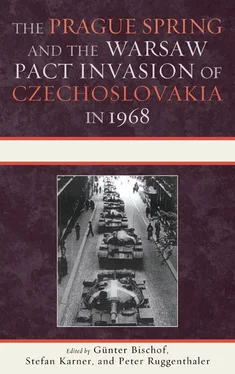It may be said by way of conclusion that the role played by the KGB in the Czechoslovak events was an extremely important one. In addition to gathering intelligence data on the situation in Czechoslovakia and on the tendencies and activities of the members of the KSČ leadership, the KGB operatives (legal as well as illegal ones) actively influenced developments and sought to guide them into the direction desired by the Kremlin. At first, the Kremlin leaders were more than pleased when Alexander Dubček rose to power: considered to be “his own man,” Dubček was fondly referred to in Moscow as “our Sasha.” He was presumably expected to be more obliging than Novotný regarding the stationing of Soviet troops, a question that arose as early as 1966. Even though he did not do so explicitly, Brezhnev himself gave his consent at least conditionally to Novotný’s dismissal. In December 1967, he referred to the matter in talks with the Czechoslovak leadership with the words “This is nobody’s business but yours,” presumably in the hope that the new Czechoslovak leadership would be more compliant in the matter of the stationing of troops. Yet subsequent developments took an entirely different turn. The change in the leadership in January 1968 was interpreted by the Czechoslovak people as a defeat of the old totalitarian system and as a summons to start building a civil society. In the end, Dubček was unable to control the liberal forces.
If one takes the medium-term development into account, this turn of events was to the Kremlin’s advantage because it was a step in the direction of the ultimate goal: the military action and the stationing of troops in Czechoslovakia. From May 1968 onward, Moscow had deliberately stoked fears of a military invasion. From this perspective, the secret activities of the KGB, which aimed for a destabilization of the situation and general disinformation, are perfectly understandable and so is their overall result. The medium-term goal was achieved: the invasion took place. From a longterm perspective, however, all this resulted in damage to the standing of the Soviet Union. The USSR was saddled with the role of the policeman who makes use of coercive methods, yet in the countries of the Eastern Bloc and later also in the Soviet republics, tendencies toward national liberation had gained a foothold and were on the rise.
Translated from German into English by Otmar Binder, Vienna.
1. Zdeňek Mlynář, Moroz udaril iz Kremlja (Moscow: Respublika, 1992), 88.
2. Rudol’f G. Pikhoya, Sovetskii Soyuz: Istoriya vlasti, 1945–1991 (Moscow: Novosibirsk Sibirskii Khronograf, 2000), 293.
3. Mlynář, Moroz udaril , 177. Further evidence is found in the reports of a well informed Soviet journalist who worked in Prague between 1965 and 1968. See Vladlen Krivosheev, “‘ Izvestiya ’ i tanki v Prage,” Izvestiya , 22 August 1998.
4. Izvestiya , 21 August 1998.
5. AP RF, F. 3, op. 22, d. 16, p. 35, published in Andrei N. Artizov et al., eds., Nikita Khrushchev: 1964, Stenogrammy plenumov TsK KPSS i drugie dokumenty (Moscow: Materik, 2007), 281–85.
6. Underscored by hand in the original.
7. AP RF, F. 3, op. 22, d. 17, pp. 17–20.
8. AP RF, F. 3, op. 22, d. 17, p. 20.
9. AP RF, F. 3, op. 22, d. 17, p. 17. The term “Line Five” apparently alludes to the Fifth Department of the KGB dealing with “ideological diversion.”
10. This is a reference to a political activist, V. Klochkov, who fought with the Panfilov division and was killed in 1941 in the defense of Moscow. The myth relating the heroic deeds of the “28 Panfilovci” (Klochkov being one of them) has remained alive to this day in the collective memory of the Russians, notwithstanding the fact that as early as 1948 the USSR’s Judge Advocate General’s Corps had presented an expert claiming the whole story was the fabrication of one A. Krivickii, a journalist with the paper Krasnaya Zvezda . N. Petrov, “O. Edel’man, Novoe o sovetskikh geroyakh,” Novyi mir 6 (1997): 140–51.
11. Istochnik 2 (1996): 112.
12. Istochnik 2 (1996): 116.
13. AP RF, F. 3, op. 80, d. 453, p. 17, Resolution No. 676–222 of the Council of Ministers of the USSR, 17 July 1967, published in Aleksandr Kokurin and Nikita Petrov, eds., Lubyanka: VChK-OGPU-NKVD-NKGB-MGB-MVD-KGB, 1917–1991: Spravochnik (Moscow: Demokratija, 2003), 711.
14. Prior to this, on 20 October 1966, the department had been spun off from the espionage directorate and made over into an independent subdivision of the central apparatus of the KGB of the Council of Ministers of the USSR.
15. AP RF, F. 3, op. 80, d. 453, p. 70, Politburo resolution of the CC CPSU 84 (91), 4 June 1968.
16. AP RF, F. 3, op. 80, d. 453, p. 71, letter no. 1252-A, Yuri Andropov’s letter, 30 May 1968.
17. AP RF, F. 3, op. 80, d. 453, pp. 70–71 (see note 15).
18. RGANI, F. 3, op. 72, d. 145, p. 7, Politburo resolution of the CC CPSU 67 (III), “On Questions Concerning Czechoslovakia,” 25 January 1968.
19. See Vyacheslav Selemenev, “Der ‘Prager Frühling’ und Weißrussland,” in Karner et al., Beiträge , 929–40.
20. RGANI, F. 2, op. 3, d. 7, pp. 39–40, Stenogramm der Sitzung des Plenums des ZK der KPdSU, 9., 10 April 1968. See Markus Holler, “‘Für eure Freiheit und unsere!’ Demonstranten am Roten Platz,” in Karner et al., Beiträge , 849–68; and Vladislav Zubok, “Soviet Society and the Prague Spring,” in this volume.
21. See Mark Kramer, “Ukraine and the Soviet-Czechoslovak Crisis of 1968,” Cold War International History Project Bulletin 10 (1998): 234–47.
22. RGANI, F. 2, op. 3, d. 7, pp. 31–32 (cf. note 20 above).
23. RGANI, F. 2, op. 3, d. 7, p. 53.
24. Until he was made director of the KGB in May 1967, Yuri Andropov was head of the Department for Liaison with Communist and Workers’ Parties in Socialist Countries of the CC CPSU from February 1957. After 1962, he was also the secretary of the CC CPSU and, therefore, in charge of these matters.
25. AP RF, F. 3, op. 91, d. 88, pp. 114–21, Document no. 951/A-OP.
26. AP RF, F. 3, op. 91, d. 88, pp. 114–21, Document no. 951/A-OP.
27. AP RF, F. 3, op. 91, d. 90, pp. 7–8.
28. Aleksandr Mayorov, “Esli vy zhivy—prostite… ,” Izvestiya , 21 August 1998.
29. The integrated command exercises and maneuvers “Sˇumava” (“Bohemian Forest”) took place in June and July 1968 with the participation of the operative commands of the Czechoslovak, Soviet, Hungarian, East German, and Polish armies.
30. AP RF, F. 3, op. 91, d. 93, p. 1, Politburo resolution of the CC CPSU, P 82 (II) “On the Question of the Situation in Czechoslovakia,” 23 May 1968.
31. Mikhail Rachyanovich Sagatelyan (1927–1988) was an international correspondent of the paper Izvestiya from 1968 to 1974 and codirector of the Novosti Press Agency from 1974.
32. AP RF, F. 3, op. 91, d. 94, pp. 27–36.
33. AP RF, F. 3, op. 91, d. 94, pp. 27–36.
34. AP RF, F. 3, op. 91, d. 94, pp. 27–36.
35. “Uroki avgusta 68,” Izvestiya , 22 August 1995.
36. “Uroki avgusta 68,” Izvestiya , 22 August 1995.
37. “Uroki avgusta 68,” Izvestiya , 22 August 1995.
38. Christopher Andrew and Vasili Mitrokhin, The Mitrokhin Archive: The KGB in Europe and the West (London: Allen Lane, 1999), 329.
39. RGANI, Archive of the Resolutions of the Secretariat of the CC CPSU, Resolution of the Secretariat, Art. 50/172g-OP, 16 April 1968.
40. RGANI, Archive of the Resolutions of the Secretariat of the CC CPSU, Resolution of the Secretariat, Art. 50/172g-OP, 16 April 1968, 328–34.
Читать дальше












